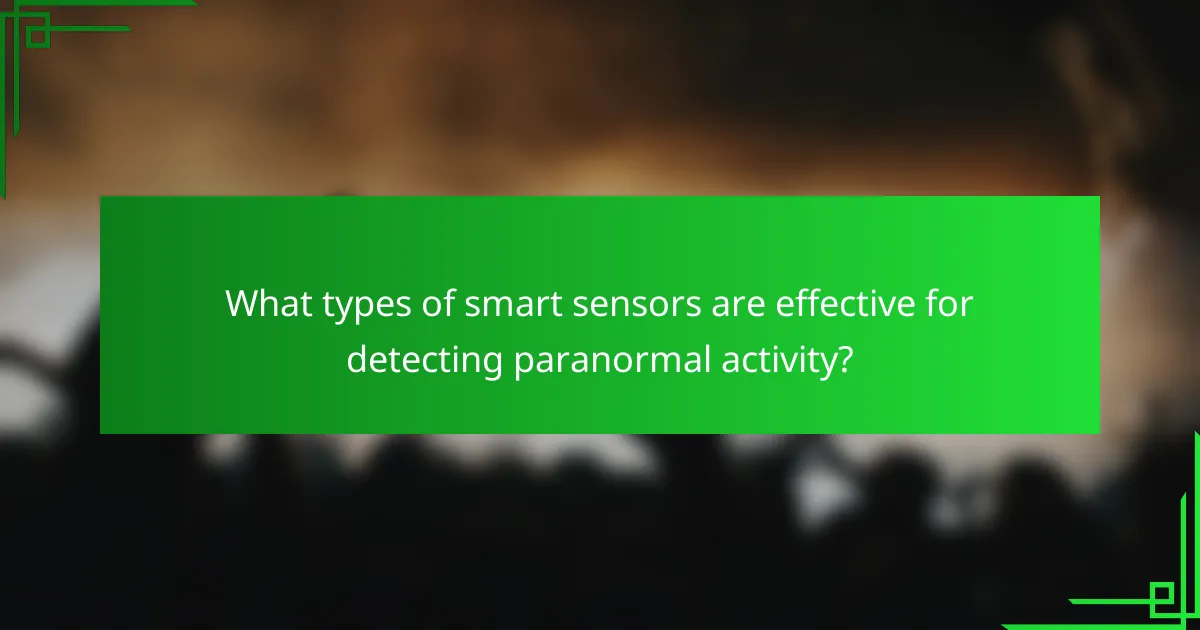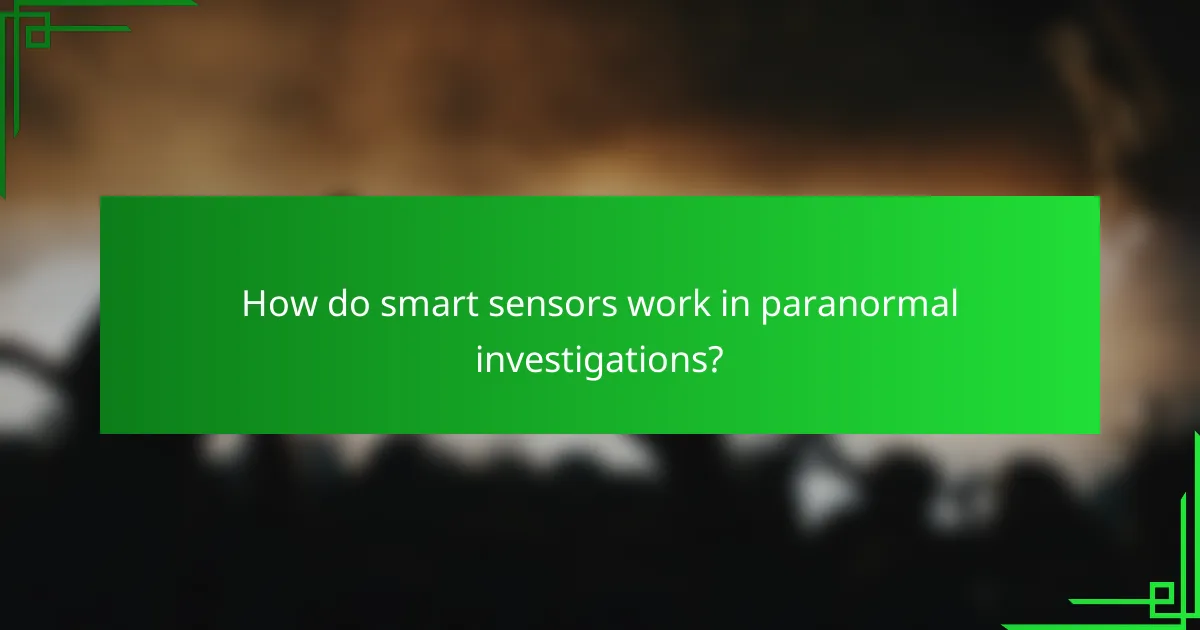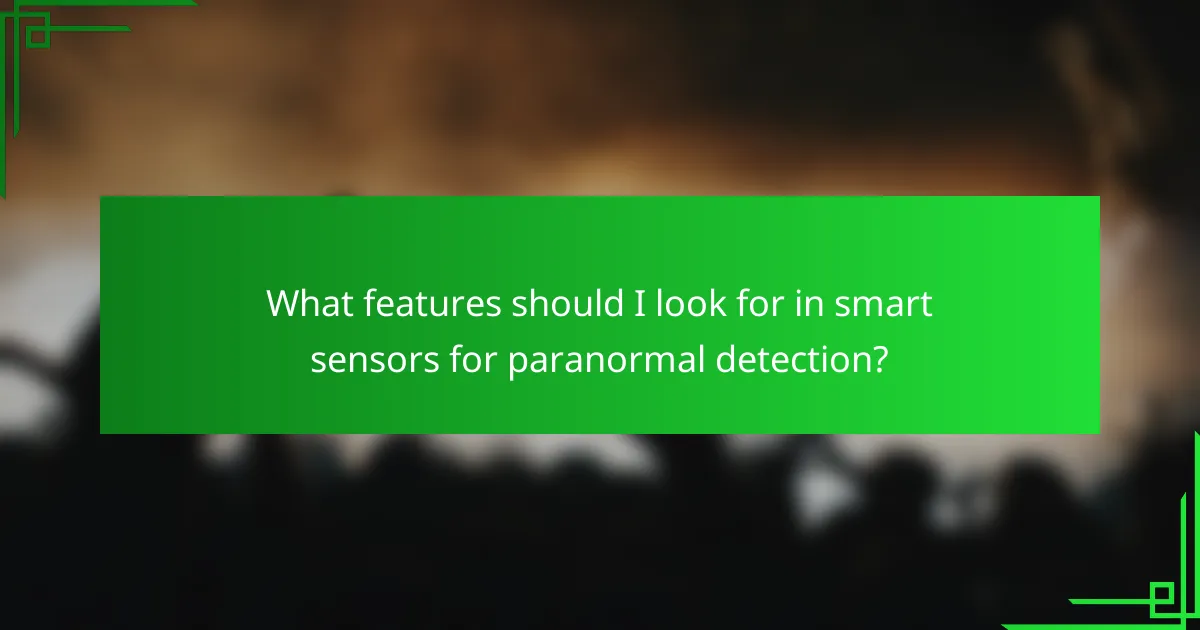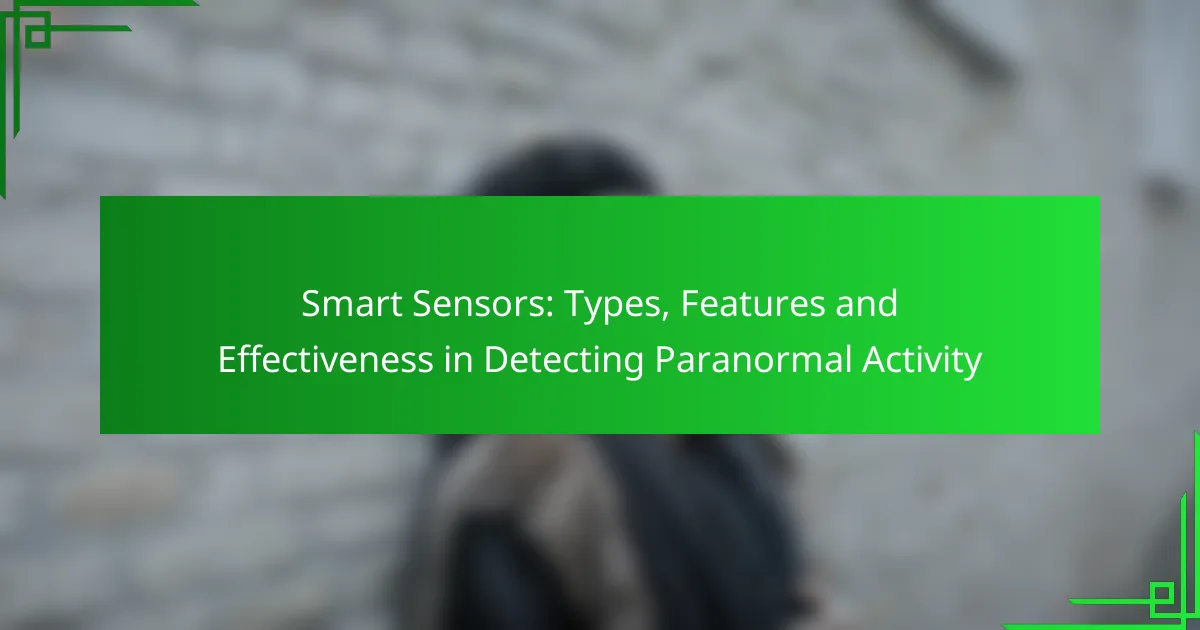Smart sensors have emerged as valuable tools in the investigation of paranormal activity, offering various types such as infrared motion sensors, ultrasonic sensors, and temperature sensors. These devices are designed to detect and analyze environmental changes, providing real-time monitoring that can help enthusiasts and researchers identify unusual occurrences. When choosing smart sensors, it’s essential to consider features like wireless connectivity and battery life to enhance their effectiveness and reliability in detecting potential paranormal phenomena.

What types of smart sensors are effective for detecting paranormal activity?
Several types of smart sensors can be effective in detecting paranormal activity, including infrared motion sensors, ultrasonic sensors, magnetic field sensors, temperature sensors, and vibration sensors. Each type has unique features that may help identify unusual occurrences in a given environment.
Infrared motion sensors
Infrared motion sensors detect changes in heat signatures, making them useful for identifying movement in low-light conditions. They work by sensing the infrared radiation emitted by objects, particularly living beings, and can trigger alerts when unexpected motion is detected.
When using infrared sensors, consider their range, which typically spans several meters. Position them in areas where paranormal activity is suspected, ensuring they have a clear line of sight to maximize effectiveness.
Ultrasonic sensors
Ultrasonic sensors emit high-frequency sound waves and measure the time it takes for the waves to bounce back. This technology can detect movement and changes in the environment, making it suitable for identifying disturbances that may indicate paranormal activity.
These sensors are often used in security systems and can cover a wide area. However, they may be less effective in environments with heavy background noise or obstacles that can interfere with sound waves.
Magnetic field sensors
Magnetic field sensors monitor fluctuations in magnetic fields, which can be indicative of paranormal phenomena. These sensors can detect changes caused by moving objects or entities that may not be visible to the naked eye.
When deploying magnetic field sensors, ensure they are calibrated correctly to distinguish between normal environmental variations and potential paranormal activity. They are particularly useful in locations with reported ghost sightings or unexplained events.
Temperature sensors
Temperature sensors measure changes in ambient temperature, which can be a sign of paranormal activity, such as cold spots often reported in haunted locations. These sensors can provide real-time data and alerts when sudden temperature drops occur.
For optimal use, place temperature sensors in areas where temperature fluctuations are suspected. Be aware that normal environmental factors, like drafts or heating systems, can affect readings, so consider these variables when interpreting results.
Vibration sensors
Vibration sensors detect physical disturbances or movements, which can be associated with paranormal activity. They can pick up vibrations from footsteps, objects being moved, or other unusual occurrences.
To effectively use vibration sensors, install them in locations prone to unexplained noises or movements. Keep in mind that they may also pick up vibrations from external sources, such as traffic or construction, so careful placement is essential for accurate detection.

How do smart sensors work in paranormal investigations?
Smart sensors in paranormal investigations function by detecting and analyzing environmental changes that may indicate unusual activity. These devices utilize various technologies to collect data, process signals, and provide real-time monitoring, which can help enthusiasts and researchers identify potential paranormal phenomena.
Data collection methods
Smart sensors employ several data collection methods, including electromagnetic field (EMF) detection, temperature variations, and sound analysis. EMF sensors can identify fluctuations in electromagnetic fields, which some believe are associated with paranormal entities. Temperature sensors can detect sudden drops or spikes, while audio sensors capture sounds that may not be audible to the human ear.
Many devices combine these methods for comprehensive data collection. For instance, a multi-sensor device might monitor EMF levels while simultaneously recording temperature and sound, providing a more holistic view of the environment being investigated.
Signal processing techniques
Signal processing techniques are crucial for interpreting the data collected by smart sensors. These techniques can filter out background noise and enhance relevant signals, making it easier to identify anomalies. For example, advanced algorithms can analyze sound waves to distinguish between normal environmental sounds and potential paranormal activity.
Additionally, some sensors utilize machine learning to improve their accuracy over time. By learning from previous data, these systems can better recognize patterns that may indicate paranormal events, thus increasing their effectiveness in investigations.
Real-time monitoring capabilities
Real-time monitoring capabilities allow investigators to receive immediate feedback from smart sensors during paranormal investigations. This feature is essential for quickly identifying unusual occurrences as they happen, enabling researchers to capture evidence that might otherwise be missed.
Many smart sensors can connect to mobile devices or computers, providing alerts and visualizations of data in real-time. This connectivity enhances the investigation experience, allowing users to make informed decisions about where to focus their efforts based on live data trends.

What features should I look for in smart sensors for paranormal detection?
When selecting smart sensors for paranormal detection, prioritize features that enhance their effectiveness and reliability. Key aspects include wireless connectivity, battery life, and integration with mobile applications, which collectively improve user experience and data accessibility.
Wireless connectivity
Wireless connectivity is crucial for smart sensors used in paranormal detection, as it allows for real-time data transmission to your devices. Look for sensors that support Wi-Fi or Bluetooth, enabling you to monitor activity remotely without being physically present.
Consider the range of the wireless connection; a good sensor should maintain a stable connection over distances of at least 30 meters indoors. This ensures that you can receive alerts and data updates even from different rooms or outdoor areas.
Battery life
Battery life is an essential feature for smart sensors, especially if you plan to use them in remote locations. Aim for sensors that offer a battery life of several months to a year, depending on usage frequency and sensor type.
Some models come with rechargeable batteries, while others use standard AA or AAA batteries. Choose a sensor that fits your convenience and maintenance preferences, as frequent battery changes can be a hassle during long investigations.
Integration with mobile apps
Integration with mobile applications enhances the functionality of smart sensors by allowing you to receive alerts, view data logs, and customize settings from your smartphone. Look for sensors that offer user-friendly apps compatible with both iOS and Android devices.
Features to consider in the app include real-time notifications, historical data analysis, and the ability to control multiple sensors simultaneously. This integration can significantly streamline your paranormal investigations and improve data management.

How effective are smart sensors in detecting paranormal activity?
Smart sensors can be moderately effective in detecting paranormal activity, depending on their type and the environmental conditions. These devices utilize various technologies, such as motion detection, temperature changes, and electromagnetic field (EMF) readings, to identify unusual occurrences that some may attribute to paranormal phenomena.
Accuracy rates
The accuracy rates of smart sensors in detecting paranormal activity vary significantly based on the technology used. For instance, motion sensors may have accuracy rates exceeding 90% in detecting movement, while EMF sensors can show varying reliability due to interference from electronic devices. It’s crucial to consider that false positives can occur, especially in environments with high electromagnetic interference.
In practice, users should combine data from multiple sensors to improve overall accuracy. For example, correlating temperature fluctuations with EMF readings can provide a clearer picture of potential paranormal events.
Case studies of successful detections
Several case studies highlight the effectiveness of smart sensors in identifying paranormal activity. In one instance, a team used a combination of motion detectors and thermal cameras in an abandoned building, successfully capturing unexplained movements and sudden temperature drops that coincided with reported ghost sightings.
Another notable case involved the use of EMF sensors in a historic site, where spikes in electromagnetic fields were recorded during nighttime investigations. These findings were later corroborated by eyewitness accounts of strange occurrences, suggesting that smart sensors can play a valuable role in paranormal research.

What are the best smart sensor brands for paranormal activity detection?
The best smart sensor brands for detecting paranormal activity include Philips Hue, Ring, and Samsung SmartThings. These brands offer various sensors that are effective in monitoring unusual movements and environmental changes, which can be indicative of paranormal events.
Philips Hue motion sensors
Philips Hue motion sensors are designed primarily for smart lighting but can also be utilized for detecting movement in a space. They use passive infrared technology to sense motion, triggering lights when activity is detected. This feature can help identify unexpected movements in dark areas, potentially indicating paranormal activity.
When using Philips Hue sensors, consider their range of about 5 to 10 meters and the angle of detection, which is typically around 100 degrees. Positioning them strategically in areas of interest can enhance their effectiveness in monitoring for unusual occurrences.
Ring security cameras
Ring security cameras are equipped with advanced motion detection capabilities and high-definition video recording. They can alert users to movement in real-time, making them suitable for monitoring spaces where paranormal activity is suspected. The cameras also feature night vision, which is crucial for capturing events in low-light conditions.
To maximize their effectiveness, ensure that Ring cameras are placed at vantage points and connected to a reliable power source. The subscription plan for cloud storage can also be beneficial, allowing users to review footage of any unusual activity that may occur.
Samsung SmartThings sensors
Samsung SmartThings sensors offer a range of devices, including motion and environmental sensors that can detect changes in temperature, humidity, and movement. These sensors integrate with the SmartThings ecosystem, allowing for automation and notifications based on detected activity. They can be particularly useful in monitoring for fluctuations that might suggest paranormal phenomena.
When setting up SmartThings sensors, consider their compatibility with other smart devices in your home. This integration can enhance the overall monitoring experience, providing alerts and automating responses to detected movements or environmental changes.

How do smart sensors compare to traditional paranormal detection methods?
Smart sensors offer advanced capabilities compared to traditional paranormal detection methods, primarily through enhanced data collection and analysis. These sensors can detect a wider range of stimuli, including temperature fluctuations, electromagnetic fields, and sound frequencies, providing a more comprehensive view of potential paranormal activity.
Cost-effectiveness
Smart sensors can be more cost-effective than traditional methods, especially when considering the long-term investment. While initial costs may be higher, their ability to provide continuous monitoring and data analysis can reduce the need for frequent manual investigations.
For example, a smart sensor system might range from a few hundred to a couple of thousand dollars, depending on features and capabilities. In contrast, traditional equipment often requires separate purchases for each device, which can add up quickly.
When evaluating cost-effectiveness, consider the potential savings on labor and time. Smart sensors can operate autonomously, allowing investigators to focus on analysis rather than setup and monitoring, ultimately leading to more efficient use of resources.
